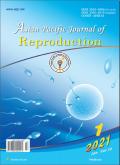Effects of N-acetylcysteine on growth, viability and reactive oxygen species levels in small antral follicles cultured in vitro
IF 0.6
Q4 REPRODUCTIVE BIOLOGY
引用次数: 0
Abstract
Objective: To investigate the effects of different concentrations of N-acetylcysteine on follicular growth and morphology, as well as on viability, levels of reactive oxygen species (ROS) and meiotic progression of oocytes from in vitro cultured bovine early antral follicles. Methods: Isolated early antral follicles (about 500 μm) were cultured in TCM-199+ alone or supplemented with 1.0, 5.0 or 25.0 mM N-acetylcysteine at 38.5 °C with 5% CO2 for 8 days. Follicle diameters were evaluated at day 0, 4 and 8 of culture. At the end of culture, the levels of ROS, chromatin configuration and viability (calcein-AM and ethidium homodimer-1 staining) were investigated in the cumulus-oocyte complexes. Comparisons of follicle diameters between treatments were performed. Data on percentages of morphologically normal follicles, growth rates and chromatin configuration in different treatments were compared. Results: An increase in follicular diameters after culture in all treatments was observed, except for follicles cultured with 25.0 mM N-acetylcysteine. Fluorescence microscopy showed that oocytes cultured in all treatments were stained positively with calcein-AM, and that 5.0 mM N-acetylcysteine reduced fluorescence for ethidium homodimer-1. Intracellular levels of ROS in oocytes from follicles cultured with 1.0 mM N-acetylcysteine showed a significant reduction compared to other treatments. The presence of N-acetylcysteine in culture medium did not influence the rates of oocyte at the germinal vesicle stage. Conclusions: N-acetylcysteine at concentrations of 1.0 and 5.0 mM reduces ROS levels and staining for ethidium homodimer-1 in in vitro cultured follicles, respectively, while 25.0 mM N-acetylcysteine decreases follicular growth and the percentages of continuously growing follicles.n -乙酰半胱氨酸对体外培养小腔卵泡生长、活力和活性氧水平的影响
目的:研究不同浓度的N-乙酰半胱氨酸对体外培养的牛早期窦卵泡卵母细胞的生长和形态、活力、活性氧水平和减数分裂进程的影响。方法:分离的早期窦状卵泡(约500μm)在单独或补充1.0、5.0或25.0mM N-乙酰半胱氨酸的TCM-199+中,在38.5°C和5%CO2下培养8天。在培养的第0、4和8天评估卵泡直径。培养结束时,研究卵丘-卵母细胞复合物中ROS水平、染色质结构和活力(钙黄绿素AM和乙锭同源二聚体-1染色)。对不同治疗之间的卵泡直径进行比较。比较了不同处理中形态正常卵泡的百分比、生长率和染色质结构的数据。结果:除用25.0mM N-乙酰半胱氨酸培养的卵泡外,在所有处理中均观察到培养后卵泡直径增加。荧光显微镜显示,在所有处理中培养的卵母细胞均被钙黄绿素AM阳性染色,并且5.0mM N-乙酰半胱氨酸降低了同二聚乙锭-1的荧光。与其他处理相比,用1.0mM N-乙酰半胱氨酸培养的卵泡卵母细胞中ROS的细胞内水平显著降低。培养基中N-乙酰半胱氨酸的存在不影响卵母细胞在生发泡阶段的比率。结论:浓度为1.0和5.0 mM的N-乙酰半胱氨酸分别降低体外培养卵泡中的ROS水平和同二聚乙锭-1的染色,而25.0 mM的N乙酰半胱氨酸降低卵泡生长和持续生长卵泡的百分比。
本文章由计算机程序翻译,如有差异,请以英文原文为准。
求助全文
约1分钟内获得全文
求助全文
来源期刊

Asian Pacific Journal of Reproduction
Veterinary-Veterinary (all)
CiteScore
1.70
自引率
0.00%
发文量
588
审稿时长
9 weeks
期刊介绍:
The journal will cover technical and clinical studies related to health, ethical and social issues in field of Gynecology and Obstetrics. Articles with clinical interest and implications will be given preference.
 求助内容:
求助内容: 应助结果提醒方式:
应助结果提醒方式:


